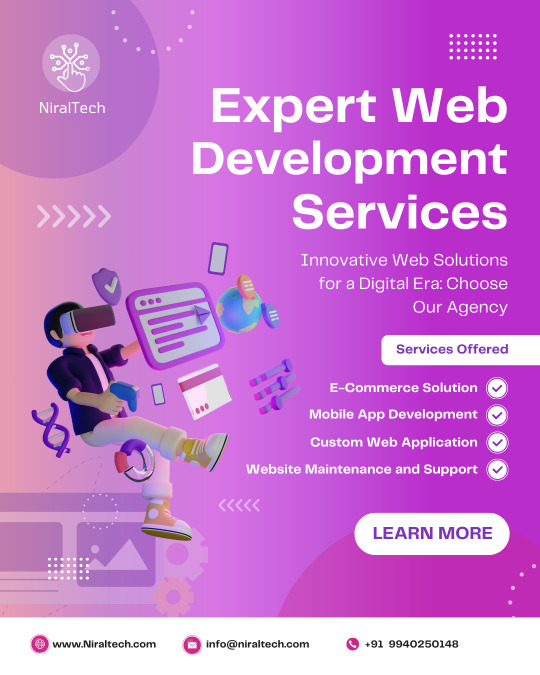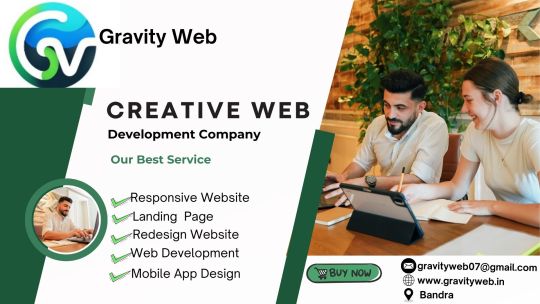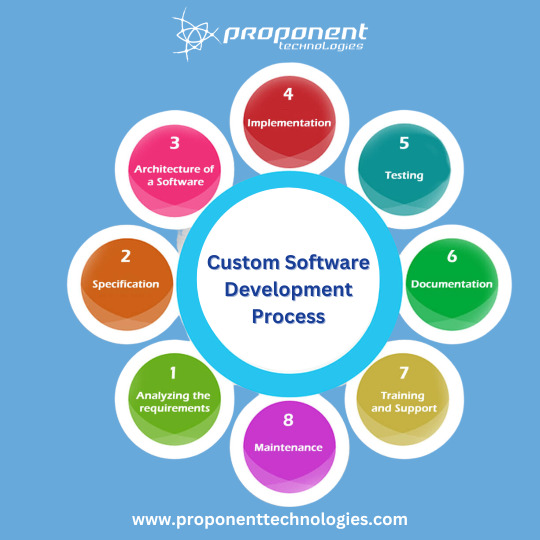#java developer for business software development
Explore tagged Tumblr posts
Text
Java developers are in high demand, and for a good reason - they can build robust, and scalable apps that can handle even the most complex business needs. But with so many options out there, how will you ensure you're selecting the right company to hire Java developers?
This blog will assist you with that. Here, we'll talk about the best ways to hire Java developers and how it will simplify the software development process according to experts.
#hire java developers#guide for hiring java developers#java development company#hire java programmer#java developers for hire#business software development#java developer for business software development#software development company#asp.net development#.net development
0 notes
Text
Web Development Service
🤩"Innovative Web Solutions for the Digital Age: 😍Choose Our Agency"💭Imagine a web page so gorgeous, it's like a 🤔dreamy tropical vacation for your eyes. And guess what? This beauty doesn't discriminate based on screen size.😇 With responsive web design, it's like having a loyal sidekick 😎that adapts to any device like a pro⚡. No more🤏 pinching, zooming, or awkward scrolling😎. It's like having a personal genie👉 that makes all your web design wishes come true! 🤙Reach us now Your Dreams 💭comes true in🤩 NiralTech - Contact Number - 09940250148

#webdevelopment#webdesign#webdeveloper#html#website#css#digitalmarketing#coding#programming#javascript#seo#websitedesign#webdesigner#developer#programmer#web#marketing#wordpress#python#ecommerce#coder#design#software#code#softwaredeveloper#java#business#graphicdesign#technology#perumbakkam
3 notes
·
View notes
Text

Computer Courses Near Me
TechWise Academy offers a diverse range of Computer Courses Near Me designed to meet the needs of today’s technology-driven world. Located conveniently near you, the academy provides classes that cater to both beginners and advanced learners looking to enhance their technical skills. Whether you're interested in learning basic computer operations, advanced software programming, or cutting-edge technologies like artificial intelligence and data analysis, TechWise Academy has a course for you.
#sumero#sumeroeducation#ravishsir#ravishchaudhary#ravish#computer#technology#pc#tech#gaming#laptop#computerscience#programming#software#coding#pcgaming#windows#computers#gamer#programmer#business#apple#python#developer#code#java#gamingpc#coder
0 notes
Text
Web development Courses
Unlock your potential in web development with our comprehensive course! Dive into HTML, CSS, JavaScript, and more. Master the skills needed to create stunning websites and applications. Join us today and start building your future in tech!

#webdevelopment#webdesign#webdeveloper#html#website#css#digitalmarketing#coding#programming#javascript#seo#websitedesign#webdesigner#developer#programmer#web#marketing#wordpress#python#ecommerce#coder#design#software#code#php#softwaredeveloper#java#business#graphicdesign#technology
0 notes
Text

The Best Web Development Company Noida India-Galaxy Web Tech
In the fast-paced digital landscape of Noida, India, having a solid web presence is vital for businesses to thrive. Galaxy Web Tech stands tall as the premier web development company in Noida, offering innovative solutions for businesses of all sizes. For more information, visit our website at www.galaxywebtech.com
#webdevelopment#webdesign#webdeveloper#html#website#css#digitalmarketing#coding#programming#javascript#seo#websitedesign#webdesigner#developer#programmer#web#marketing#wordpress#python#ecommerce#coder#design#software#code#php#softwaredeveloper#java#business#graphicdesign#technology
0 notes
Text
#webdevelopment#webdesign#webdeveloper#html#website#css#digitalmarketing#coding#programming#javascript#seo#websitedesign#webdesigner#developer#programmer#web#marketing#wordpress#python#ecommerce#coder#design#software#code#php#softwaredeveloper#java#business#graphicdesign#technology
0 notes
Text
The World of Android Software Development Company

At Sciflare, we dive deep into the world of Android software development, crafting exceptional apps that meet your specific needs. Android software development company: Our team of experts breathes life into your ideas, turning them into intuitive and user-friendly experiences for millions of Android users. Reach us- Sciflare Technologies
#android#software#mobile app development#software company#mobile technology#application services#business#android world#kotlin#java
0 notes
Text
Web development company in bandra
Gravity Web is your go-to web development company in Bandra, Mumbai. We specialize in creating custom websites that drive business growth. Whether it's e-commerce or a business site, we've got you covered. Our expert team delivers top-notch service to meet your needs. Contact us to transform your online presence. https://gravityweb.in/website-designing-company-in-bandra.php

#webdevelopment#webdesign#webdeveloper#html#website#css#digitalmarketing#coding#programming#javascript#seo#websitedesign#webdesigner#developer#programmer#web#marketing#wordpress#python#ecommerce#coder#design#software#code#php#softwaredeveloper#java#business#graphicdesign#technology
1 note
·
View note
Text
Streamlining Java Application Migration: Key Strategies for Efficient Services
Discover essential strategies for optimizing Java application migration services with expert collaboration. Learn how to navigate the process smoothly for enhanced efficiency and success. 24/7 Customer Support is available.
0 notes
Text
#software#technology#programming#tech#coding#developer#business#softwaredeveloper#programmer#javascript#python#java#computer#html#hardware#webdevelopment#tecnologia#code#webdeveloper#softwareengineer#erp#webdesign#computerscience#o#coder#css#development#softwaredevelopment#android#it
0 notes
Text
Master the art of software development with our Advanced Java course! 🚀 Dive into cutting-edge technologies like Spring Boot, Microservices, Docker, Kubernetes, Git, CI/CD, and AWS. Elevate your skills, transform your career. Enroll now for a journey into the future of software excellence!
Reach us: 8870275880
Software Development Course
#software#technology#programming#tech#coding#developer#business#softwaredeveloper#programmer#javascript#python#java#computer#html#hardware#webdevelopment#tecnologia#code#webdeveloper#softwareengineer#erp#webdesign#computerscience#o#coder#css#development#softwaredevelopment#android#it
0 notes
Text

Graphic Designing Course In Delhi
The curriculum spans essential topics such as typography, color theory, layout design, branding, and digital illustration, Graphic Designing Course In Delhi with a strong emphasis on mastering industry-standard software like Adobe Photoshop, Illustrator, and InDesign.
#sumero#sumeroeducation#ravishsir#ravishchaudhary#ravish#computer#technology#pc#tech#gaming#laptop#computerscience#programming#software#coding#Accounting Course#pcgaming#windows#computers#gamer#programmer#business#apple#python#developer#code#java#gamingpc#coder
0 notes
Text
Top 20 Full Stack Developer Interview Questions

Preparing for a Full Stack Developer interview can be tough but worthwhile. To help you excel and stand out during your interview, we have gathered the top 20 Full Stack Developer interview questions that cover the necessary skills and concepts. Whether you want to secure your dream job or take your Full Stack Developer career to new heights, these questions will be your ultimate resource. Let’s dive in and get you ready for success in your Full Stack Developer interview.
1. What is a full-stack developer?
A full-stack developer is a skilled professional who can handle both front-end and back-end development tasks. They have the ability to work on all aspects of web development, including creating the user interface, managing server-side logic, and handling database interactions for web applications.
2. Explain the difference between GET and POST HTTP methods.
The GET method is used to get data from a server. It’s usually used for reading data. The POST method is to send the data to a server. It’s used for creating or updating data. GET requests are usually cached, but POST requests are not.
3. What is CSS, and how is it used in web development?
CSS (Cascading Style Sheets) is a stylesheet language that is used to control the visual appearance of web pages. It is used to specify colors, fonts, spacing, and layout. CSS is essential for developing aesthetically and responsive web designs.
4. What is a RESTful API?
A RESTful API (Representational State Transfer) is a design style for networked applications. It applies HTTP requests to carry out CRUD (Create, Read, Update, Delete) operations on resources, and it follows statelessness and uniform resource identifiers (URIs) concepts.
5. Explain the role of HTML in web development.
HTML is a HyperText Markup Language used to make web pages. It helps create the layout and content of a webpage using elements and tags. HTML is important for making the main structure of a webpage, like headings, paragraphs, lists, and links.
7. Explain the role of JavaScript in web development.
JavaScript is a powerful programming language that may be used to add interaction and functionality to web sites. It can be used for activities such as form validation, DOM manipulation, asynchronous processes, and the development of interactive online apps.
8. What is Node.Js, and how does it differ from JavaScript in the browser?
Node.js is a server-side runtime environment that allows you to run JavaScript. It differs from JavaScript in the browser in that it can handle HTTP requests, file I/O, and database interactions on the server.
9. Describe the difference between SQL and NoSQL databases.
SQL databases are relational databases that manipulate data using structured query language (SQL). Non-relational databases (NoSQL) store and retrieve data in a variety of formats, including JSON, XML, and key-value pairs. NoSQL databases are more adaptable and appropriate for dealing with massive amounts of unstructured data.
10. What is MVC architecture, and how does it benefit web development?
MVC (Model-View-Controller) is a web development design structure. The program is divided into three parts: the Model (data and logic), the View (user interface), and the Controller (which takes user input and updates the Model and View). MVC encourages the organization, modularity, and maintainability of programming.
11. Explain the concept of middleware in Express.Js.
Middleware functions in Express.js are functions that have access to the request and response objects in an HTTP request-response cycle. They are capable of doing activities such as authentication, logging, and altering request or response data. To process requests in a specified order, middleware functions can be chained together.
12. How do you optimize the performance of a web application?
Web application performance optimization can include a variety of measures such as reducing HTTP requests, utilizing content delivery networks (CDNs), optimizing pictures, activating browser caching, and decreasing server response times. Techniques such as code minification and lazy loading can also aid in performance enhancement.
13. What is authentication and authorization in web development?
Authentication is the process of authenticating a user’s identity, generally using login credentials. The process of establishing what activities and resources a user is permitted to access based on their authenticated identity is known as authorization. They work together to guarantee that users have access to the right sections of a web application.
14. Explain the concept of Single Page Applications (SPAs).
SPAs are web apps that load a single HTML page and update the content as the user interacts. They use JavaScript for navigation and rendering, giving a seamless user experience without reloading the entire page.
15. What is the purpose of Unit Testing in web development?
Unit testing is a testing method in which individual units of code (e.g., functions, methods) are tested in isolation to ensure that they function as expected. Unit tests in web development helps in the early detection and correction of defects, thereby enhancing code quality and maintainability.
16. What is the role of a web server in web development?
A web server is software that processes incoming HTTP requests and serves web pages or resources to clients (often web browsers). It handles responsibilities such as routing, HTTP method handling, and dynamic content or serving static.
17. Explain the concept of microservices architecture in web development.
Microservices is a design principle that divides a web application into small, independent services that communicate over APIs. Each service serves a unique purpose and may be built, deployed, and scaled separately. This design enhances flexibility, maintainability, and scalability.
18. Explain the role of caching in web applications.
Caching is the temporary storage of frequently accessed data or resources in order to reduce server load and improve the performance of web applications. It minimizes bandwidth usage and speeds up website loading times by providing cached material to users.
19. What are Progressive Web Apps (PWAs), and what benefits do they offer?
PWAs are web applications that resemble the experience of native apps in web browsers. They provide advantages like faster loading times, offline access, and push alerts, making them an appealing option for web development.
20. What is the purpose of API Gateways in full-stack development?
API gateways act as intermediaries for client apps and microservices or backend APIs. They simplify the management of APIs in distributed systems by providing features such as request routing, authentication, rate limitation, caching, and load balancing.
#datavalley#dataexperts#data engineering#data analytics#dataexcellence#business intelligence#data analytics course#power bi#data science#data science course#java full stack training#full stack training#full stack web development#full stack course#full stack developer#full stack software developer#full stack development training program
0 notes
Text
Web development Courses
Comprehensive Coding Skills: Master the full stack development cycle, from front-end design to back-end functionality. Project-Based Learning: Apply your knowledge to real-world projects, building a robust portfolio. Versatility: Equip yourself to work seamlessly across various development platforms

#webdevelopment#webdesign#webdeveloper#html#website#css#digitalmarketing#coding#programming#javascript#seo#websitedesign#webdesigner#developer#programmer#web#marketing#wordpress#python#ecommerce#coder#design#software#code#php#softwaredeveloper#java#business#graphicdesign#technology
0 notes
Text

Elevate your business with Proponent Technologies' India-based custom software development. We transform your vision into reality through cutting-edge solutions, meticulous craftsmanship, and unwavering commitment to your success. For more information and a free quote contact us at- ➡️𝗠𝗮𝗶𝗹: [email protected] ➡️𝗖𝗼𝗻𝘁𝗮𝗰𝘁 𝗻𝗼.: +91 6397 593 103
#software#technology#programming#tech#coding#developer#business#softwaredeveloper#programmer#javascript#python#java#computer#html#hardware#webdevelopment#tecnologia#code#webdeveloper#softwareengineer#development#webdesign#computerscience#customsoftware#coder#css#softwaredevelopment#android#it
0 notes